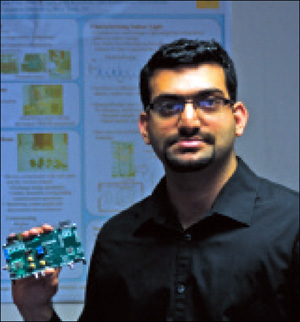Futurists have envisioned a day when low-cost radio frequency identification sensors will monitor soil conditions across large farms and gather data in hostile or remote environments, such as rivers contaminated with chemical spills and rain forests. But there’s a basic challenge that must be met to make this vision a reality: How do you deploy large numbers of sensors over a vast area?
One way would be to sprinkle RFID transponders with sensors from unmanned aerial vehicles or piloted aircraft. But this is problematic, because it would be impossible to control the orientation of a transponder’s antenna so it could be read easily. Sensors could be designed to self-orient by weighting the bottom, but this would require more mass and probably more expense. Another option would be to create sensors with spikes, but these wouldn’t work on hard terrain.

Researchers at the Center for Nanoscale Science and Engineering, at North Dakota State University, Fargo, have come up with a simple solution—a ball-shaped sensor with a near-isotopic antenna, which can be read from any direction with the same intensity. Michael Reich, a senior research engineer and adjunct faculty member, and Layne Berge, a graduate student, have developed such a device and tested a proof of concept. They used a 3-D printer to create a structure just 5 centimeters in diameter to house a sensor, double dipole antenna and printed circuit board, and attached a conventional Alien Technology Higgs-3 chip to the antenna. A concept sensor that incorporates a three-axis accelerometer has also been manufactured and tested.
“We are only getting about a meter to a meter and a half read range,” Reich says. “Obviously, we have some work to do to try to increase that.”
To that end, Reich and Berge are looking for funding from private companies interested in developing sensors that could detect certain chemicals after a spill, moisture in soil or lack of moisture in wilderness areas prone to fires. “Right now, we’re not focused on a particular application,” Reich says. “We want to build a platform that could be adapted to suit a variety of needs.”
The research is still in the early stages, but he and his colleagues seem to be on a roll.

